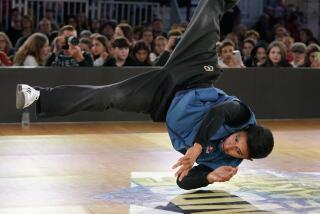Jake Brown’s epic fall is not forgotten
- Share via
It has been six years, but fans still ask Jake Brown the same questions: “How did it feel? What was going through your head? How are you still alive?”
It’s understandable, but how Brown walked away from a 45-foot free fall really isn’t.
It has become the main part of his legacy in the skateboarding big air event — not landing the first ollie 720, winning a gold medal after years of trying or skating on two broken ribs in Barcelona earlier this year.
“I haven’t really seen too much of that change. It’s still the same six years since I did that,” Brown said. “Yeah it’s always brought up, but I’m just here to skate and try to help us progress. I just want to leave a positive mark on the sport.”
On that day in 2007, the Australian landed the first 720 in big air competition over a 55-foot gap before losing control, his body flailing in mid-air before smacking the wood ramp. His shoes flew 50 feet, his head was under his back due to the whiplash and the Staples Center crowd was eerily silent.
Fellow big air gold medalist Bob Burnquist was at the top of the ramp when he thought he saw his friend for the last time.
“I fell on the ground and started crying because I thought he had died,” Burnquist said.
Brown’s injuries were a fractured wrist, fractured vertebrae, bruised liver, bruised lung, ruptured spleen and concussion. And yet he still got up and walked off.
Two years later, Brown won the gold medal in that same event, when he realized mental preparation underneath the helmet is almost as important as technical prowess above the board.
“I thought I was good right away, but it took me a couple of years to mentally get back to where I wanted to be,” Brown said. “Everything is heightened at that level: the danger, the rush, the reward.”
Skateboarding big air became an X Games event in 2004 after skateboarding legend Danny Way brought the crazy idea and his mega ramp setup to ESPN.
He grew tired of seeing Motocross and snowboarding get the glory for going big. Something had to be done, bigger and bolder than ever before.
“The world of skateboarding was a bit shocked when they saw that stage open up for everybody. Everyone was intimidated, as was I,” Way said. “But mega ramp was my vision to get skateboarding to catch up with the rest of the sports on that level.”
Way won the first three big air events and it’s his impact that has made it one of the most anticipated events at the X Games each year.
Way, 39, has been on an X Games hiatus and said he hopes to return within the next two years, but his impact reaches across all skaters, cultures and ages. In 2005, Way used a mega ramp to jump the Great Wall in China and is currently filming a video in Hawaii.
“It’s human nature to push the limit,” Way said. “I don’t know how long I’m going to be doing this for. I know there is so much that hasn’t been done that needs to be done and I know I am capable of doing some of that stuff before it is too late.”
It has even caught on with a younger generation of thrill-seeking skaters. Thirteen-year-old Tom Schaar, who finished sixth last year, will compete in big air to kick off the first day of the X Games at the Irwindale Event Center on Thursday.
Meanwhile, Burnquist, who was born and raised in Brazil, has won the last five big air events. He even has a mega ramp setup in his backyard in Vista, Calif.
“I’m just surviving,” Burnquist said. “It’s always scary. It always was and it always will be.”
But with bigger air comes bigger expectations, a dangerous component of an event known for its extreme falls.
“Jake’s fall was catastrophic,” Way said. “Those types of things put what we do into perspective. It’s what we fear most. That’s the reality of the risk.”
Brown acknowledged it’s a risk worth taking for the danger, the rush, the reward. But with big air, it’s go big or go home, hopefully in one piece.
Twitter: @andrewgastelum
More to Read
Go beyond the scoreboard
Get the latest on L.A.'s teams in the daily Sports Report newsletter.
You may occasionally receive promotional content from the Los Angeles Times.










